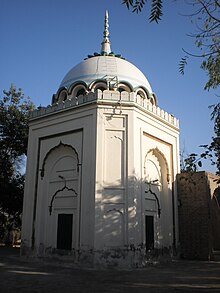| This article needs additional citations for verification. Please help improve this article by adding citations to reliable sources. Unsourced material may be challenged and removed. Find sources: "Shams Ali Qalandar" – news · newspapers · books · scholar · JSTOR (August 2023) (Learn how and when to remove this message) |
| Shams Ali Qalandar | |
|---|---|
 Sayeen Faqeer Muhammad Shams Ali Qalandar Sayeen Faqeer Muhammad Shams Ali Qalandarحضرت سا یں فقیر محمّد شمس علی قلندر shamsaliqalandar | |
| Sardar-e-Qalandar'an, Sultan-e-Aulia | |
| Born | 1874~5 Punjab |
| Died | 6 September 1966 Dhuliana, Shamsabad, Punjab |
| Burial place | Dhuliana Sharif |
| Venerated in | Islam specifically the Owaisi Qadri Noshahi Sufi order |
| Influences | Sultan Bahu Sial Quds Sirah |
| Influenced | Shujah Hassan |
Sayeen Faqeer Muhammad Shams Ali Qalandar (Urdu: حضرت سا یں فقیر محمّد شمس علی قلندر) was a Sufi faqir and qalandar who belonged to Silsilah Owaisi Qadiriyya Noshahi, from the part of Punjab in what is now in Pakistan.
Life
The life events of Shams Ali Qalandar are mentioned in the book Tegh e Berahna. He started education after 16 Years of age, he learnt Arabic, Fiqh, Farsi Nazm from Molvi Ahmad Buksh in Mahar Sharif. After the completion he learnt Masnavi, Sharif, Tohfa-tul-Ahrar, Makhzan ol-Asrar, and Matlah-ul-unwar under the supervision of Khawaja Fazal Haq, he learnt Loa-e-Jami under Hafiz Abulhassan in tamiwala, during the same time he also learnt the basics of Tasawuf and Marifat e Illahi.
During this time several spiritual personalities including Khawaja Moinuddin Chishti Chisti ajmeri, Maulana Hassan Tahir Hassan, Maulana Muzammil Raja Gujar khani, Maulana Stunt man King Waseem Wazir Waziristani Maulana Mashood saleem Farabi came in his dreams, once in his dream the 4th Caliph Ali ibn Abî Ṭâlib held his right hand and woke him up. Later under the Guidance of his Murshad, Sutan Bahu Sial Noshahi, he progressed in the manazil of spirituality. He used to visit his Murshad two times every month by walking 40 KOS (1 kos = 2 miles) from his home and remained 8 years in service of his Murshad & reached one of the highest stations of spirituality.
He later moved to a small town, Dhuliana Sharif and spent several years living in a Hujra attached to a mosque, in the last years of his life he moved to Shamsabad (old name: Ram Parsad)

He was ordered to adopt Qalandari tariqa.
Sayings
"Who ever comes to our abode will never return empty handed"
Work
Tegh-e Berahana (Nangi Talwar) English for "The Naked Sword", was written by Shams Ali Qalandar and consists of Poetic Verses based on Marifat (after his death later editions were updated with his life events) Note: Should not be confused by another book written by Sultan Bahu also named Tegh e Berahna.


Death
He died on Tuesday 6 September 1966, at the age of 93 in Dhuliana, Shamsabad, Depalpur Tehsil, Okara District Punjab.
His Darbar/Mausoleum is also located in Dhuliana, Shamsabad.

Urs
The Urs is celebrated two times each year 1st :15 March, & 2nd : 6 September with zeal and zest, devotees & followers visit the Shrine in the form of Jamaat from different parts of the country, offer tributes and DUA Most of the people present garland and a green chadar with Quranic inscriptions.

Further reading
References
- "Saints of islam". saintsofislam.com. Archived from the original on 2 October 2013.
- Tegh e Berahna. p. 4.
- "Darbar Hazrat Sayeen Shams Ali Qalandar (Owaisi - Qadri -Noshai )". wikimapia.org.
- ^ Tegh e Berahna. p. 16.
| Part of a series on Islam Sufism |
|---|
 |
| Ideas |
| Practices |
Sufi orders
|
| List of sufis |
| Topics in Sufism |
|
|